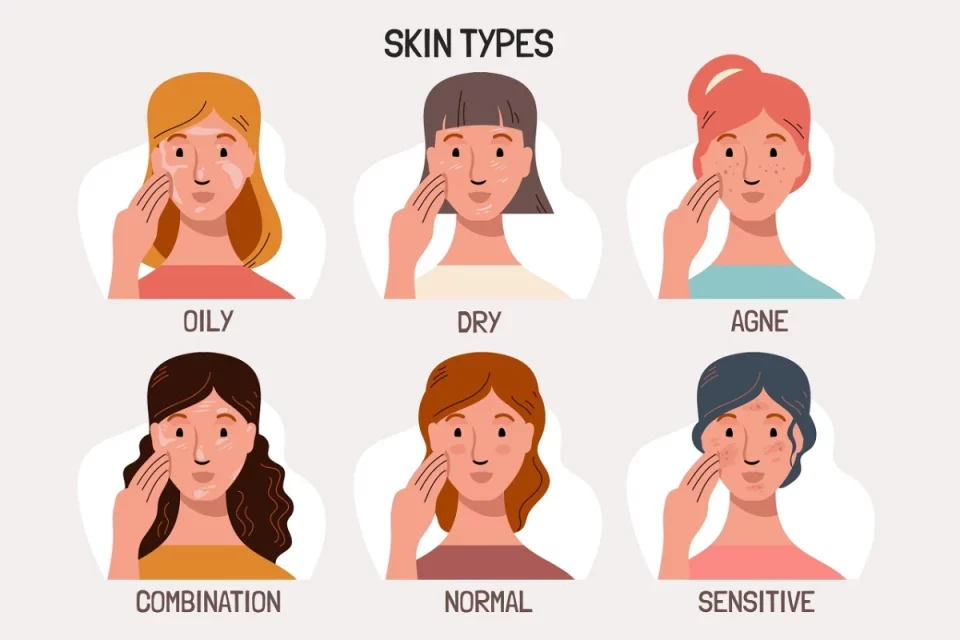Table of Contents
Introduction
There is four primary skin types, and here are their characteristics: If you have dry skin, your sebum production is insufficient. This phenomenon creates tightness, discomfort, redness, and flaking on the skin. Your skin is also dull and rough to the touch. Wrinkles and fine lines are more marked (accentuating skin ageing). Your skin is thinner, does not shine, and its pores are tightened or almost invisible.
If your skin is smooth, soft, neither too oily nor too dry, has few blemishes, does not shine, your pores are smooth, your complexion is even, and you do not feel discomfort or tightness, then your skin is of a so-called typical type.
You probably have combination skin if the skin in the T-zone (forehead, nose, chin) is oily while the skin on the cheeks, temples and maxillaries is normal (that is, it does not pull, is uniform and does not shine), your pores are dilated and visible. And it may have imperfections in the midline of the face.
If your complexion is shiny, your skin tends to glow all over the face, it is thicker, the skin texture is irregular, it is prone to blackheads and blemishes, and your pores are dilated. In this case, you certainly have oily skin.
How To Deal With Skin Conditions?
However, in addition to these four skin families, you may have to deal with skin conditions that can change depending on the season, age, sun exposure or hormonal fluctuations. These skin conditions can affect all skin types and accumulate between them:
Dehydrated skin: Dehydration can affect all skin types, even in combination with oily skin. It is due to a lack of water in the skin, unlike dry skin lacking fat. It causes a feeling of temporary tightness on localized areas without necessarily flaking, presents fine lines and a lack of radiance of the complexion.
Sensitive skin is considered acute when it marks and warms up quickly. Indeed, it reacts disproportionately to external aggressions, stress and emotions. People with sensitive skin feel discomfort: tightness, persistent redness, and frequent skin irritations.
Mature skin: With age, the production of collagen, elastin and hyaluronic acid gradually decreases, causing sagging skin, fine lines and wrinkles, pigment spots, loss of elasticity, firmness, volume and radiance of the skin, bags under the eyes and dehydration.
Acne-prone skin: Contrary to popular belief, acne does not only affect people with oily skin or teenagers. Indeed, regardless of skin type, many women suffer from hormonal acne in adulthood.
How Do You Know What Your Skin Type Is?
To have healthy and luminous skin, it is essential to know its skin typology to be then able to adapt your care to the needs of your epidermis. Here are some straightforward tips that will help you determine your skin type:
Prepare your skin: Start by cleansing your skin well. First, with the help of a makeup remover, remove any traces of makeup on your face and impurities and excess sebum. To perfect your skin cleanse, then wash your face with a gentle washing treatment.
Rinse your face thoroughly with warm water and gently wipe your skin with a clean towel to dry. Then wait an hour while the sebaceous glands resume their activity. During this time, do not apply any products to your skin and avoid touching it to avoid distorting your judgment.
Get To Know Your Skin Type Through The Diagnosis
The skin is more complex than we think, and Typology has studied the subject more closely. According to a scientific methodology, we determined 24 different skin typologies.
Therefore, to discover your skin typology and receive a personalized beauty routine prepared by our experts according to your skin’s needs, carry out our skin diagnosis by answering a few questions about your skin and sharing your specific concerns.


